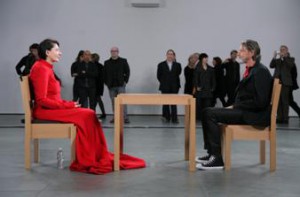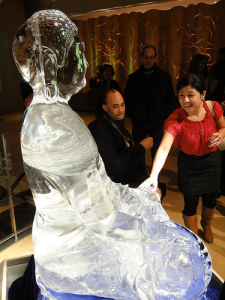As I browsed through I went the MoMA and , a site where the MoMA has posted responses to that question, one response stood out at me. I went to the MoMA and could still feel Marina Abramovi?s presence where she once sat for “The Artist Is Present.
For the duration of this work, about two and half months, Abramovi? sat at a table in silence while museum visitors could sit across from her and stare. Some sat for a few seconds, some sat for a few hours. But Marina Abramovi? sat every day, all day. Such a dynamic and human presence must surely have changed the history of the shared space.
Does a work of art have a presence in a space after it no longer exists in that space?
In reflecting on this big though, Atta Kims Ice Buddha jumped into my thoughts. The base of the spiral staircase, a space I usually think of as a meeting space or starting point, suddenly became the site of powerful art. In those moments of reflection before a school group arrives, I find myself looking at the spot where the Ice Buddha once sat, and wondering if anyone else is thinking about that past presence. Wondering if the ephemeral Ice Buddha still has a lasting claim to the space in which he once sat.
I have found many students who are visiting the Rubin Museum for the second or third time, remembering certain pieces. I find myself gravitating towards certain works in the museum. What will I do when that show rotates? Will I remember all of the details that have drawn me this work? Will the piece maintain a claim on the space in which it was shown?
My other favorites from the I went to the MoMA and :
I behaved for my mom
Lots of good looking people here, especially the boys.




